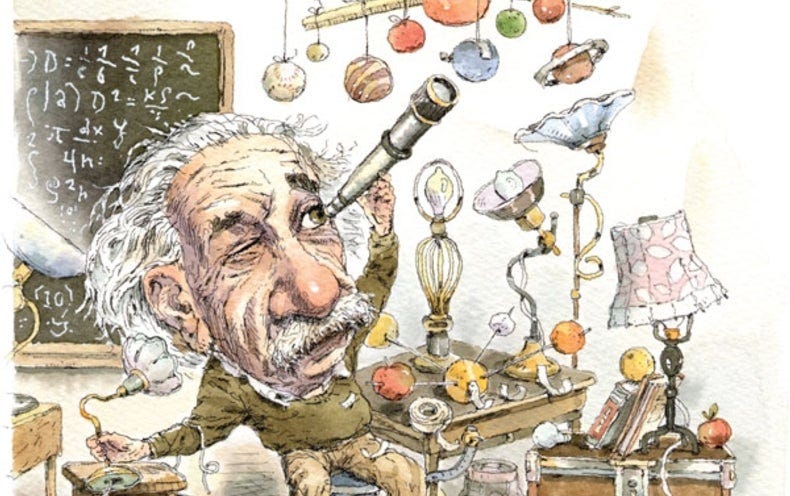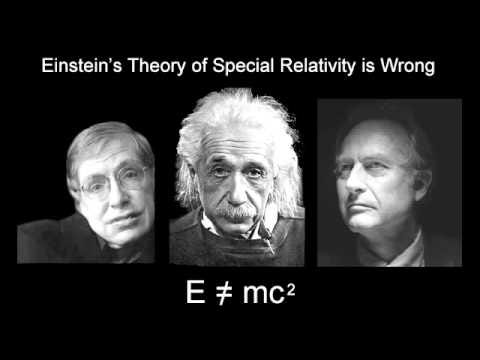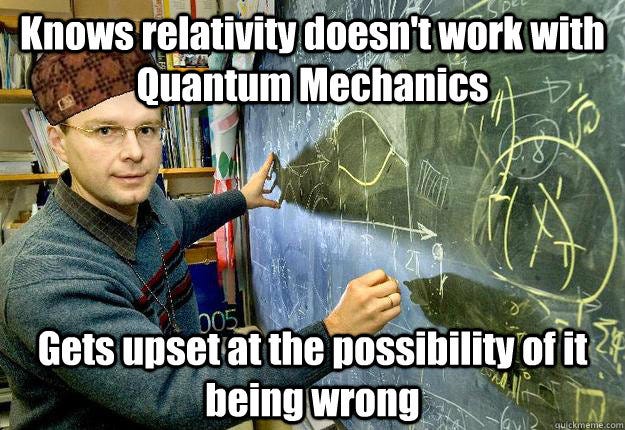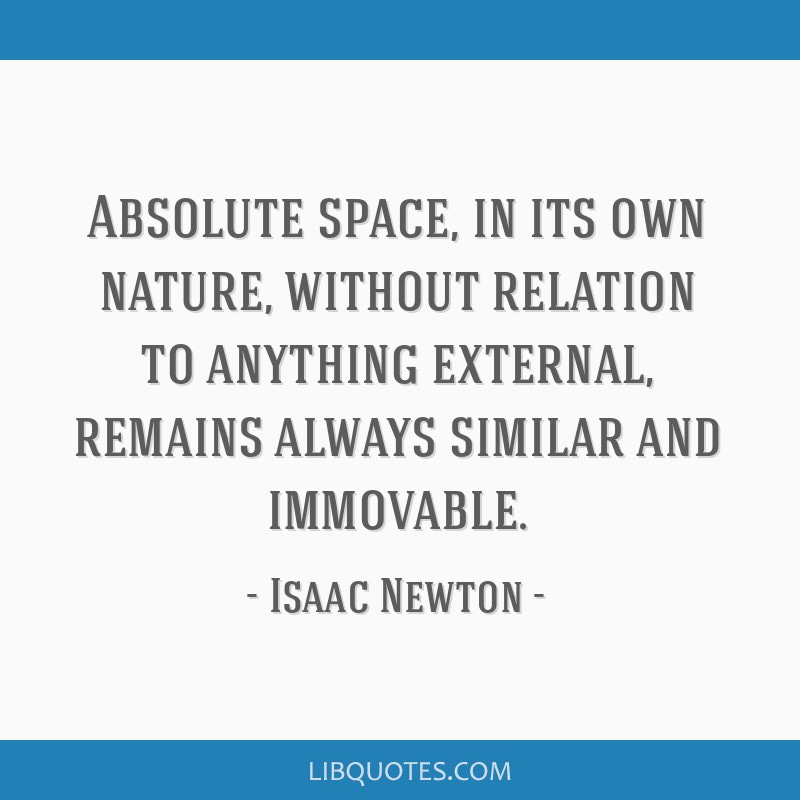Einstein and his Ether. Refuting his own theories of Relativity and make-believe.
Not the 'greatest scientist ever' but a desperate mathematician trying to prove Copernicanism and the self-created Universe.
Prologue
It was known 100 years ago that the 1905 Special Theory of Relativity or STR was wrong. Many contemporaries of Einstein eviscerated his make-believe world of flux and change, a universe with no fixed absolutes in which reality itself was optional, subject to endless unproven ‘dimensions’, untestable but necessary to support Copernicanism and the Big Bang. Einstein admits that his theory of Special Relativity is bunk by creating his General Theory of Relativity (1915-19), which included the ‘ether’, a ‘medium’ identifying absolute space, which he absolutely detested pre-1905. The insertion of an ether in his GTR is more than enough to kill off STR. If STR is bunk, then the Big Bang theory is also junk and invalidated. Copernicanism remains just a theory, still unproven regardless of confident expostulations and online apologia to the contrary.
As many other posts have detailed if there is an ether, or if the speed of light is inconstant or not confined to 186.000 miles per second velocity, or is impacted by the medium not the velocity of the ‘observer’, then STR is destroyed. Indeed, all these suppositions are true. Since STR is just a mathematical concept and lies at the heart of both heliocentricity and Big Bang theology, they too must be jettisoned or at the very least, be coerced to provide some real tangible evidence for their claims.
Greatest Scientist evah….
In 1905, in his STR paper, ‘the greatest scientist in world history’ declared:
“The introduction of a ‘light ether’ will prove to be superfluous, because the view here to be developed will introduce neither a ‘space at absolute rest’ provided with special properties, nor assign a velocity vector to a point of empty space in which electro-magnetic processes take place.” (Einstein, 17, Sept. 26, 1905).
As this post and the next will outline, space is not empty. What Einstein was really attempting to do was refute the Fizeau (1851) and Michelson experiments (1881, 1887) which had inadvertently disproved heliocentricity and Earth mobility, as well as diurnal rotation. To do this, he needed to remove all absolutes from ‘The Science’. The absolutes of space and time were for Einstein, the core reasons why Earthly mobility was not measurable.
As a diehard Copernican faithful, Einstein’s religious-philosophical outlook was paramount in his abstract mental experiments. Only Relativity could explain why we can’t measure the Earth’s 108.000 km per hour trot around the Sun, or why we can’t mechanically prove the Earth’s rotation. No absolutes were to be allowed including space and rest (an example being the Earth’s immobility). All objects must be in relative motion in a ‘vacuum’ or ‘absolute’ nothingness. A vacuum does not mean an absence of material reality. It means the absolute nothingness of no material or physical reality.
Relativity and its pseudo-make-believe world of maths and theories would therefore come to the Copernican rescue and save ‘The Science’. But it was mandatory for Einstein that no absolute ether was to be allowed. Ether or the medium of space, was however central to Maxwell, Lorentz and Poincare’s mathematics and theorems and an indispensable foundation for electromagnetic theory and physics.
Einstein consumed and reused Maxwell and Lorentz’s maths almost in toto within his STR and GTR frameworks, without bothering to reference his debt to their theories or affirming his reuse of their hard work. His disciples and cheerleaders praise this lack of referencing as ‘saving time’ because the annotations are ‘so obvious’. Or maybe it simply denotes laziness, a capacity to mislead and hints of fraud. Such attitudes and actions were typical of Einstein as they were with Galileo.
Big Al recants
Eleven years later in 1916, the acclaimed ‘greatest scientist in history’ wrote:
…in 1905 I was of the opinion that it was no longer allowed to speak about the ether in physics. This opinion, however, was too radical, as we will see later when we discuss the general theory of relativity. It does remain allowed, as always, to introduce a medium filling all space and to assume that the electromagnetic fields (and matter as well) are its states…once again “empty” space appears as endowed with physical properties, i.e., no longer as physically empty, as seemed to be the case according to special relativity. One can thus say that the ether is resurrected in the general theory of relativity….Since in the new theory, metric facts can no longer be separated from “true” physical facts, the concepts of “space” and “ether” merge together. (Einstein, “cited in Kostro, p. 2).
So, in 11 years, the ‘greatest scientist who ever existed’, the massive brain which overshadows all others, completely overturns his own personal theory and the attempt to save Copernicanism and embraces the ‘absolute’ reality that space is not a ‘vacuum’ and is not ‘nothing’. And how many people know this? The cheerleaders of ‘The Science’ praise this of course as ‘science correcting itself’. No. It has nothing to do with real science, but with trying to ‘save the phenomena’ of Copernicanism and its misanthropic ‘principle’.
The make-believe world of Special Relativity
As a committed Copernican Einstein was horrified by the litany of failed 19th century experiments which disproved the Earth’s orbit around the Sun, and its diurnal rotation (many posts on this substack outline these). Such redounding failures led Einstein and ‘The Science’ to believe that perhaps the ether had no effect on objects because, as these experiments had apparently proved, a light beam traveling with the Earth’s velocity of 30 km/sec against the ether (the purported speed of our planet as it races around the Sun), experienced no reduction in its speed when compared to a light beam that was not traveling against the ether.
Given that light speed seemed independent of an ether, perhaps it was possible to jettison the concept altogether? The underlying assumption for Einstein and ‘The Science’ was always that the Earth was mobile. The possibility of immobility was dismissed. This bias left only 2 suppositions for Einstein and ‘The Science’ when looking at the litany of failed 19th and 20th century experiments which could not prove the Earth’s mobility.
(a) that ether traveled with the Earth in its revolution around the Sun; or
(b) there is no ether, and light itself is an absolute
Einstein decided that the ‘ether train’ around the Earth, dragged by the Earth in its sprint around the Sun, could not exist. It would be too close to Newton’s ‘absolute space’. He therefore plumped for option b, that there is no ether, and the speed of light is an absolute.
Einstein could now rewrite physics and history. He could reference the failed heliocentric experiments from Arago and Fizeau, to Michelson and Sagnac, as supportive of his Relativity theory, based as it was on the constant speed of light and ignore that these experiments did not prove the constancy of light speed (Sagnac proved that light was inconstant) and ignore that they disproved Earth mobility.
Very convenient.
‘The Science’ could thus appropriate disproofs of heliocentricity as proofs of Relativity which ‘proved’ heliocentricity (it doesn’t of course and has nothing to say about the Earth’s purported orbit around the Sun). This is what every textbook and information gatekeeper now claims.
Einstein crafted option (b), that light speed was absolute, and an ether impossible, into a though experiment, divorced from any mechanical proof and dreamt up Special Relativity. In STR if there is no ether, and all the heavenly bodies are in motion, then there is no absolute state of rest and no central point in the universe, especially not the Earth. Every object can act as its own inertial point. Every object will be subject to the same laws, and we, the observers, can understand how one object relates to the next only by means of the equations of Relativity theory.
Relativity would therefore be the ‘unifying’ theory of cosmology and physics, explaining motion, light speed, relativistic time clocks and how the universe operated within a Newtonian framework. It seemed ‘simpler’ and ‘more elegant’ than the complicated world of ether dynamics. But of course, STR is far more complicated than reality, based as it is on only maths and thought experiments needing extensions to Euclidean geometry and tensor calculus to give it the pastiche of mathematical veracity.
STR is thereby only an intellectual construct attempting to explain the relationships between moving objects. The idea is that if the math can explain such relationships there is no need for an ether, or absolute space (both considered the same by Einstein). A fixed and absolute Earth is also therefore without merit. The confusing and poorly understood array of STR calculus, length contractions, time dilations, mass increases and gravitational warping seem for abstract theorists, a more interesting and sophisticatedly intellectual method of explaining the universe, than the simplified (and to such abstract minds ‘simpleton’) notion of a fixed Earth in a revolving sphere of stars. It is a philosophical, not a scientifically-proven program.
Not so fast Al
Thus prior to his apostasy in 1915 to 1916, Einstein had decided by himself, that there can never be absolute space, or absolute rest. Every object must be mobile, and all motion and velocities must be independent of any fixed grid, or position. Any absolute rest or space nullifies STR. Any ether invalidates STR.
His contemporaries were not that enthused about STR. The great French mathematician Henri Poincaré continued to insist upon the existence of ether for three main reasons:
(1) stellar aberration (a medium aberrating the travel of light, confirmed by the Arago and Airy experiments);
(2) ‘action-at-a-distance’ whereby gravity and electromagnetism could be transmitted over vast distances (Newton and Maxwell);
(3) rotational motions (confirmed in Sagnac’s 1913 experiment) (Poincaré, pp. 18-19)
Einstein never provided proofs, experiments, or even good enough maths to refute the above. All 3 were proved by DC Miller employing the most advanced interferometer experiments ever undertaken in history, lasting some 20 years (an entire post on this substack explains his 300.000 experiments).
In 1923 German physicist Ernst Gehrcke published an article in which he reexamined the Michelson-Morley, Michelson-Miller, and Georges Sagnac experiments, concluding that Relativity theory simply did not have a good explanation for the results. Note that Einstein did not perform one single experiment to support his mental exercises, nor did he bother to refute Gehrcke, Sagnac or Miller. (Gehrcke, pp. 292-299).
Minimalist Ether
By 1920 like a bad post-modern or beaux-arts architect, Einstein needed an ether as part of his architecture, but not a muscular, tangible ether. He needed an almost invisible, transparent ether, a ‘relativistic ether’, which would satisfy both STR and GTR. He also needed to create more complex maths and theories no one would understand to ‘unify’ and bridge his two thought-experiments.
Einstein needed ether to account for the physical effects of action-at-a-distance and rotational motion, but he did not want to give ether any physical attributes, because that would nullify both his Relativity theories. As ‘the greatest scientist ever’ plainly states:
“The special theory of relativity forbids us to assume the ether to consist of particles observable through time, but the hypothesis of ether is itself not in conflict with the special theory of relativity. Only we must be on our guard against ascribing a state of motion to the ether.” (Einstein speech, May, 1920 Leyden address, para. 16)
What nonsense. So, pace Einstein, we can accept the concept of an ether, but only if it does not have particles or motion. The whole point of an ether is that like any medium or ‘atmosphere’ it contains particles and is subject to motion including light travel and aberration. Space is full of particles, fields and quantum fluctuations (outlined in the next post)! STR acolytes such as Arthur Eddington also began to regurgitate this party line by stating that ‘…we do deny that the aether need have such properties as to separate space and time in the way supposed.’ (Eddington p. 39).
For Einstein, Eddington et al, space-time must be combined into a 4th dimension to support the ‘curvature’ of spaced proposed by STR and to deny an immobile ether and space. The space-time continuum and its curvature were central to explain time dilation, different clock measurements and how gravity might ‘slow down’ a clock and time. The unification of space-time has never been proven, it was and is a mathematical exercise first posited by Einstein’s math teacher Minkowski, incorporated by Einstein into STR without reference to Minkowski and used to explain the paradoxes of measuring time and events in space. It also leads to ideas about multi-verses and time travel through worm-holes.
The amorphous, ill-defined, and never proven idea of ‘relativistic’ ether for GTR allowed the Einstein cult to keep the key to Relativity, namely the denial of absolute space and rest, but retain a mental-conceptual framework, to understand action-at-a-distance and rotational motion. Hypocritically however, Einstein admits that the ether does indeed possess physical qualities! Although he says a ‘conceptual’ ether has no ‘particles’ or ‘motion’ (which is 100% wrong), he then admits that it does possess some physical qualities. He writes:
‘For the mechanical behavior of a corporeal system hovering freely in empty space depends not only on relative position (distances) and relative velocities, but also on its state of rotation, which physically may be taken as a characteristic not appertaining to the system in itself. In order to be able to look upon the rotation of the system, at least formally, as something real, Newton objectivizes space. Since he classes his absolute space together with real things, for him rotation relative to an absolute space is also something real. Newton might no less well have called his absolute space “ether”; what is essential is merely that besides observable objects, another thing, which is not perceptible, must be looked upon as real, to enable acceleration or rotation to be looked upon as something real.’ (1920 Leyden address, para 18)
These are comments from either a confused scientist or a dissembler. The ether is real but not real. It depends. Where is the experimentation to prove any of it?
Appeal to Saint Newton of the Absolute Space
Einstein, floundering to save himself and his theories not to mention Newtonian mechanics and Copernicanism, throws himself onto the altar of Newton. Newton had never construed absolute claims to knowing the constitution of space or the cause of gravity, and this allows Einstein to appeal to his authority.
Apostle Einstein needed to invoke Saint Newton to ‘objectivise’ space to explain movement within it, namely object rotation and action-at-a-distance. He does this by using metrical tensor field calculus developed from the geometry of Minkowski and Riemann, without revealing what ‘physical qualities’ he will eventually attribute to space. Again, maths divorced from physical proofs or specific descriptions.
But even here Einstein ‘borrows’ from another without attribution or reference. The German physicist Paul Drude had written about a similar, quite vague concept of the ether in 1900, in his work Handbook of Optics which Einstein had read. We know this because Einstein sent a letter to Drude with his comments on the book. Drude’s explanation is reflected in Einstein’s own concepts, as Drude writes; “…if one understands by ether not a substance, but only space endowed with certain physical characteristics.’ (Kostro, Einstein and the Ether, p. 7, 18)
This is basically Einstein’s ether for his GTR. An amorphous substance with some, but never defined physical properties, which can be used to balance equations and fit into, but not obviate, the Relativity framework. How wonderfully creative.
The vagary vagueness of it all
By 1920 Einstein has completely changed his position on the ether, realizing that cosmological physics won’t exist without one. He just needed ‘something’ to support his failing theories:
“…It appeared beyond question that light must be interpreted as a vibratory process in an elastic medium filling up universal space. It also seemed to be a necessary consequence of the fact that light is capable of polarization, that this medium, the ether, must be of the nature of a solid body, because transverse waves are not possible in a fluid, but only in a solid. Thus, the physicists were bound to arrive at the theory of the “quasi-rigid” luminiferous ether, the parts of which can carry out no movements relative to one another except the small movements of deformation which correspond to light-waves.” (Einstein’s Lecture at the University of Leyden, Germany, May 5, 1920)
While he may have disagreed with previous explanations and definitions of the ‘luminiferous ether’, Einstein knew that physical reality demanded an ether as a medium of electromagnetic and light transport. Using Drude, Einstein produced 3 different types of ether by 1920.
(1) one for STR (1905);
(2) one for GTR (1915-17); and
(3) one for his failed ‘Unified Theory’ (post 1920)
The ether for the Special theory was purloined from Lorentz, but Einstein rejected it because Lorentz understood it as an immobile ether, identical to the concept held by the 1905 Nobel Prize winner Philipp Lenard and akin to the ‘absolute space’ of Newton. Einstein pre-1915 dismisses the Lorentz immobile ether and declares space to be a vacuum of nothingness. Post-1915 he changes course and desires that the immobile Lorentz ether be recast as a flexible and pliable medium, devoid of discernible physicality. By 1915-1917 General Relativity had begun to supplant in Einstein’s deliberations Special Relativity and to make it work he needs an amorphous and formless medium with gravity.
This left Einstein post 1920, to concoct a new kind of ether to unify gravity with electromagnetism, or Newton with Maxwell as part of his ‘Unified Theory’ or as his disciple and acolyte Hawking would call it, ‘’The Theory of Everything’. This led to embellishing Riemann’s geometry with six more tensor fields in addition to the ten already being used by General Relativity. This endeavor failed. Einstein could never produce a Unified Theory of anything.
Elastic definitions
We need to note that ‘The Science’ still references the nothingness of the ‘vacuum’ of space or Einstein’s original 1905 refutation of the Maxwell-Lorentz ether, a medium which was the fundamental basis for the Lorentz equations assiduously copied by Einstein who then removed the ether in his own model. Space is still described by ‘The Science’ as a ‘frictionless void’ containing ‘nothing’. We see this used when needs arise.
For example in the supposed moon landings of 1969-74, the ‘vacuum’ was used as an excuse for inter-alia: the lack of noise of the lunar landing, the lack of dust being kicked up on landing or the creation of a massive crater by the 10.000 pound rocket thruster engine, the absence of vibration and shaking of the LEM during landing, the wrongly pixilated ‘Sun’ which looks like an artificial light, shadows in different directions within the same grid frame, the lack of stars in the background, the inability to jump 8 feet in a 1/6 gravity environment, and the lack of photos of the Earth in the background as seen from the surface. The ‘vacuum’ is thus very convenient for ‘The Science’ and given Einstein’s elastic definition it can mean almost anything. It just depends on what theory you need to ‘prove’. It is all ‘relative’ anyway.
Bottom Line
The ether exists. Newton’s ‘absolute space’, Maxwell’s ‘luminiferous ether’ and Lorentz’s ‘immobile ether’, have long been confirmed to be true. Modern scientific discovery has affirmed this. We therefore know that STR is rubbish. Given the lack of physical property definition with GTR, and the amorphous ‘relativity ether’ used in GTR, it also true that GTR, as with STR, is incoherent and wrong (black holes if they exist, quantum mechanics and other phenomena disprove GTR).
Einstein never bothered with physical proofs of course. By 1920 even he could see that his Relativity endeavor was seriously flawed and expressed his angst in letters to acolytes such as Maurice Solovine and others. Hence his desire to ‘unify everything’. Einstein would never locate singularity-free equations for his General or Unified Field or UT theory. The UT consumed much of his life but quantum mechanics refused to cooperate and it was a failure (Kostro, Einstein and the Ether, pp. 138-140).
What is frankly ridiculous is that the absurdity of Einstein’s unproven theories, or his demands that ether is suspended for STR, but incorporated and valid for GTR, is still preached as gospel today. Any ether whatsoever nullifies Relativity. Period. That paradigm was long over and long in need of replacement with objective, mechanical proofs of how reality operates.
Robert Laughlin, 1993 Nobel prize winner confirms this view:
“It turns out that such matter (the ether) exists. About the time relativity was becoming accepted, studies of radioactivity began showing that the empty vacuum of space had spectroscopic structure similar to that of ordinary quantum solids and fluids. Subsequent studies with large particle accelerators have now led us to understand that space is more like a piece of window glass than ideal Newtonian emptiness. It is filled with “stuff” that is normally transparent but can be made visible by hitting it sufficiently hard to knock out a part. The modern concept of the vacuum of space, confirmed every day by experiment, is a relativistic ether. But we do not call it this because it is taboo” (Laughlin, pp. 120-121)
So, modern physics knows that the ether exists as predicted and explained by scientists from the 14th to 19th centuries. Modern physics thereby knows that STR is invalid, yet it still promotes the same calling it a vacuum in lieu of ‘relativistic ether’. Simply inane.
The reason STR is still sacrosanct is that pace Robert Laughlin, it is taboo to criticize it. Without STR Copernicanism and the Big Bang would be demolished and abolished. There is simply too much money, too much prestige, too much worship of the ‘great scientist’ Einstein; too much power accrued; too many world-views formed, too many philosophies dependent on it and too much investment by ‘The Science’, to allow STR or GTR to be dismembered.
There is also the very real threat that the Earth might well be immobile and at the universe’s barycenter. For the great and good, the self-proclaimed uber-intelligent, the devout Copernican and atheist or even deist, even a lie or mental-fiction is preferable to that ‘horrible and terrifying’ potentiality.
The bottom line is that few people know why Einstein developed his fantasy world of Relativity, or just how poorly constructed and devoid of physical proof it is. Too many are terrified of the consequences of ‘denying’ ‘The Settled Science’ by criticising the ‘great man’ and his ‘proof’. Relativity is Scientism in all its ‘glory’ and we are much the worse for it, poorer scientifically, philosophically, morally, and intellectually.
Sources
Galina Granek’s “Einstein’s Ether: Why Did Einstein Come Back to the Ether?” Apeiron, vol. 8, no. 3, July 2001; and
“Einstein’s Ether: Rotational Motion of the Earth,” Apeiron, vol. 8, no. 2, April 2001;
Ludwik Kostro, “Einstein and the Ether” Electronics and Wireless World, 94:238-239 (1988)
Ludwik Kostro, “Einstein and the Ether”, 2000.
Robert B. Laughlin, A Different Universe: Reinventing Physics from the Bottom Down, 2005
Arthur Eddington, Space, Time and Gravitation
Albert Einstein speech, May, 1920 Leyden address
Albert Einstein, “Zur Elektrodynamik bewegter Körper,” Annalen der Physik, 4th series, 17, Sept. 26, 1905
Albert Einstein, “Grundgedanken und Methoden der Relativitätstheorie in ihrer Entwicklung dargestellt,” Morgan Manuscript, EA 2070, as cited in Ludwik Kostro, Einstein and the Ether, Aperion, 2000, p. 2
Henri Poincaré, “Le Principe de relativité et ses consequences dans la physique moderne,” Archives de sciences physiques et naturalles, 29,
E. Gehrcke, “Die Gegensätze zwischen der Äthertheorie und Relativitätstheorie und ihre experimentale Prüfung,” ZftP, 4, 1923, Nr. 9









Very well articulated. You’ve thoroughly deconstructed the Scientism of Relativity, piece by piece.
Your posts are amazing. They read like a book. You’ll soon enough see more discover this profile